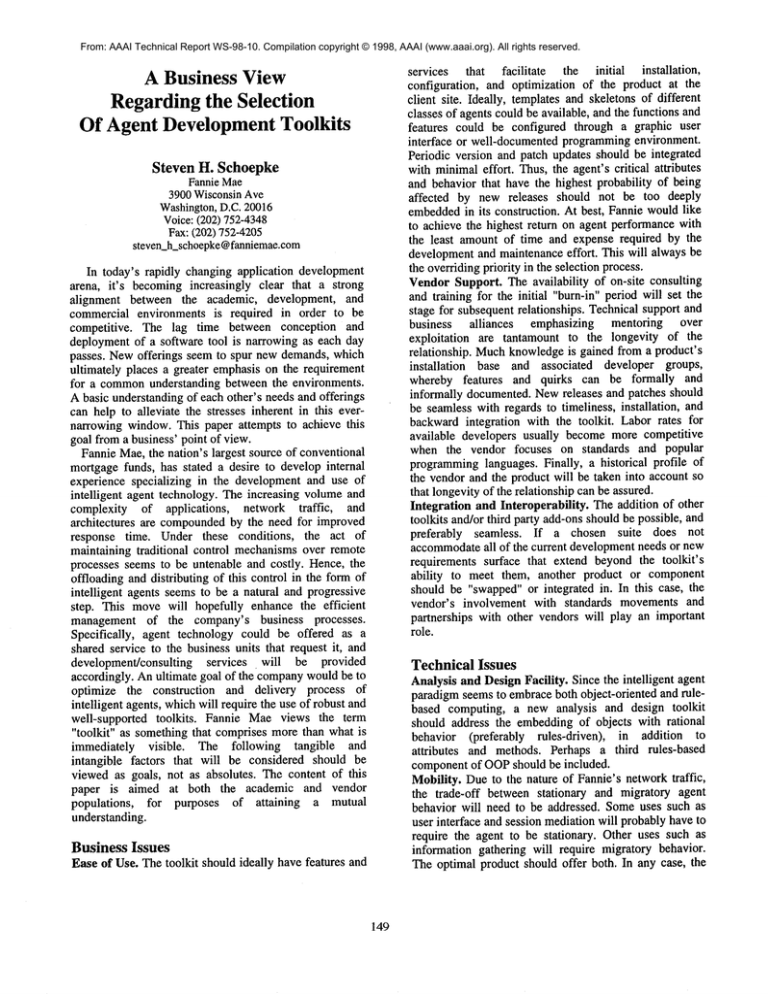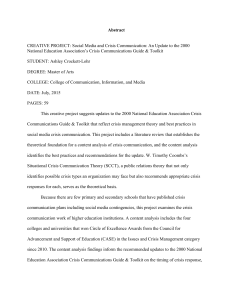
From: AAAI Technical Report WS-98-10. Compilation copyright © 1998, AAAI (www.aaai.org). All rights reserved.
services that facilitate
the initial installation,
configuration, and optimization of the product at the
client site. Ideally, templates and skeletons of different
classes of agents could be available, and the functions and
features could be configured through a graphic user
interface or well-documented programmingenvironment.
Periodic version and patch updates should be integrated
with minimaleffort. Thus, the agent’s critical attributes
and behavior that have the highest probability of being
affected by new releases should not be too deeply
embeddedin its construction. At best, Fannie wouldlike
to achieve the highest return on agent performance with
the least amount of time and expense required by the
developmentand maintenance effort. This will always be
the overriding priority in the selection process.
VendorSupport. The availability of on-site consulting
and training for the initial "burn-in" period will set the
stage for subsequent relationships. Technical support and
business alliances
emphasizing mentoring over
exploitation are tantamount to the longevity of the
relationship. Muchknowledgeis gained from a product’s
installation
base and associated developer groups,
whereby features and quirks can be formally and
informally documented. Newreleases and patches should
be seamless with regards to timeliness, installation, and
backwardintegration with the toolkit. Labor rates for
available developers usually becomemore competitive
when the vendor focuses on standards and popular
programminglanguages. Finally, a historical profile of
the vendor and the product will be taken into account so
that longevity of the relationship can be assured.
Integration and Interoperability. The addition of other
toolkits and/or third party add-onsshould be possible, and
preferably seamless. If a chosen suite does not
accommodateall of the current developmentneeds or new
requirements surface that extend beyond the toolkit’s
ability to meet them, another product or component
should be "swapped"or integrated in. In this case, the
vendor’s involvement with standards movements and
partnerships with other vendors will play an important
role.
A Business View
Regardingthe Selection
Of Agent DevelopmentToolkits
Steven H. Schoepke
Fannie Mae
3900 WisconsinAve
Washington,D.C. 20016
Voice: (202) 752-4348
Fax: (202) 752-4205
steven_h_schoepke@fanniemae.com
In today’s rapidly changing application development
arena, it’s becoming increasingly clear that a strong
alignment between the academic, development, and
commercial environments is required in order to be
competitive. The lag time between conception and
deployment of a software tool is narrowing as each day
passes. Newofferings seem to spur new demands, which
ultimately places a greater emphasis on the requirement
for a commonunderstanding between the environments.
A basic understanding of each other’s needs and offerings
can help to alleviate the stresses inherent in this evernarrowing window.This paper attempts to achieve this
goal from a business’ point of view.
Fannie Mae, the nation’s largest source of conventional
mortgage funds, has stated a desire to develop internal
experience specializing in the development and use of
intelligent agent technology. The increasing volumeand
complexity of applications,
network traffic,
and
architectures are compoundedby the need for improved
response time. Under these conditions, the act of
maintaining traditional control mechanismsover remote
processes seems to be untenable and costly. Hence, the
offloading and distributing of this control in the form of
intelligent agents seems to be a natural and progressive
step. This movewill hopefully enhance the efficient
management of the company’s business processes.
Specifically, agent technology could be offered as a
shared service to the business units that request it, and
development/consulting
services will be provided
accordingly. Anultimate goal of the companywouldbe to
optimize the construction and delivery process of
intelligent agents, whichwill require the use of robust and
well-supported toolkits. Fannie Mae views the term
"toolkit" as something that comprises more than what is
immediately visible.
The following tangible and
intangible factors that will be considered should be
viewed as goals, not as absolutes. The content of this
paper is aimed at both the academic and vendor
populations,
for purposes of attaining
a mutual
understanding.
Technical Issues
Analysis andDesignFacility. Since the intelligent agent
paradigmseems to embraceboth object-oriented and rulebased computing, a new analysis and design toolkit
should address the embedding of objects with rational
behavior (preferably rules-driven),
in addition
attributes and methods. Perhaps a third rules-based
componentof OOPshould be included.
Mobility. Due to the nature of Fannie’s network traffic,
the trade-off between stationary and migratory agent
behavior will need to be addressed. Someuses such as
user interface and session mediation will probably have to
require the agent to be stationary. Other uses such as
information gathering will require migratory behavior.
The optimal product should offer both. In any case, the
Business Issues
Ease of Use. The toolkit should ideally have features and
149
company will want to minimize the agent’s impact on
network traffic. Flexible and/or adaptive migration
itineraries and persistence of the agent’s execution state
between"hops" will be considered.
Adaptability. A toolkit should support options between
fixed and adaptable behavior, through the use of some
learning paradigm or algorithm. Criteria or rules of
appropriate behavior should be configured in the agent,
and firing of these rules should trigger changes in
subsequent behavior based on previous experience.
Autonomy.Ideally, the toolkit should provide the agent
with both fixed and dynamic itineraries.
For example,
agendas can be either procedure or rules-driven, or could
be manually adjusted in the midst of performing a series
of assignments,
possibly through interactive
communicationwith a user.
Auditing and Tracking. Information as to the agent’s
activity should be accessible through some sort of
auditing tool: logging via fixed file, messagesto consoles,
email, interactive querying via GUIs,etc. In the case of a
collaborative environment, the exchange of commands,
actions, facts and rules between active agents should be
audited, preferably in real-time. In case of mobility,
migratory behavior that’s internal and/or external to the
networkor web should be subject to the same observance.
Security. Passwordauthentication required for access to
gathered information, embeddedalerts regarding access
violations or attempts thereof, alerts for bottlenecks and
obstructions, etc. should be offered.
Architecture Independence. Heterogeneity regarding
operating on different platforms and operating systems in
the companyshould be addressed. Part of this involves
communicationprotocol independence, so that auditing
and tracking can be facilitated.
Scalability.
The toolkit should accommodate the
migration of the agent to larger or more complex
operating environments. It should also allow for the
reconfiguration of an agent’s migratory or goal-directed
behavior when the environment changes.
Sociability. Templates or class skeletons should support
team and individual behavior of constructed agents.
Ideally, team behavior of multiple agents should be
configurable through the toolkit, and strictly controlled.
The sensible allocation of roles or "talents" in a
collaborative environmentcould be a valuable feature in a
design and analysis toolkit.
practical use could be a goal-directed agent or group of
agents assigned the task of gathering information about
the company’s state through access to the various MIS
resources and files internal and external to the company.
Neural net technology could be used to discern
undesirable business patterns or trends as indicated in the
MISenvironment. Inferences could be made, stored,
routed, and presented at completion of the mission.
Results could be monitored in mid-stream of the mission
or at its completion. Ideally, a GUIinterface could be
used as a tool for auditing and presentation purposes.
Graphics, drill-down reporting, security, and user
customization wouldalso be important.
NetworkTraffic Management_.Agents specializing in
load balancing and packet rerouting could optimize the
use of networkresources.
Electronic
Commerce Negotiation.
Predefined
negotiating criteria and behavior could facilitate the
remote negotiation of loan purchases from mortgage
lenders. Search agents specializing in the location of these
desirable lenders could also play an importantpart.
Comments on Terminology
Muchof the current literature contains references to agent
personality traits such as "antagonistic", "evasive",
"dominant","controlling", and the like. In general, these
can be interpreted in the greater business environmentas
special "reserve" wordsthat should be used sparingly. As
an alternative, the terms "goal-directed", "persistent",
"adaptive", "deliberate", and "rational" may be more
appropriate terms to use when assuming a marketing
posture towards Corporate America.
Conclusion
Fannie Maesees a tremendous potential and opportunity
in the field of intelligent agents, and wishes to pursue the
development
of its internal expertise and consulting skills.
The intelligent agent concept maywell be the conduit that
AI needs in order to be brought into the corporate
mainstream. The introduction of the proper toolkits and
vendor organizations is critical to the success of this
effort. The product that can best approach the ideals
above has the highest likelihood of selection. The more
products that can make inroads into the business
environment, the more the developmentcapital that will
be madeavailable to research efforts. This could enable
the technology to be funded outside of the traditional
academic and governmentarenas, and be able to advance
accordingly. It’s imperative that theory be aligned with
necessity, since the two are not mutually exclusive and do
not exist in a vacuum.This workshoppaper has attempted
to outline the goals and desires of an active business
enterprise, hoping to inform the academic and product
development communityof somelucrative needs.
Practical Issues
User Interface and Session Mediation. Initially,
a
primary use of agent technology could revolve around
using an intelligent agent to monitor and mediate a user
session with an application. Violations and alerts from a
rules-based agent could be displayed to the user with
proper warnings. Personalization of applications on the
networkor Intranet through the use of a "learning" agent
is also an area of possibility.
Information Filtering and Translation._ Another
150



